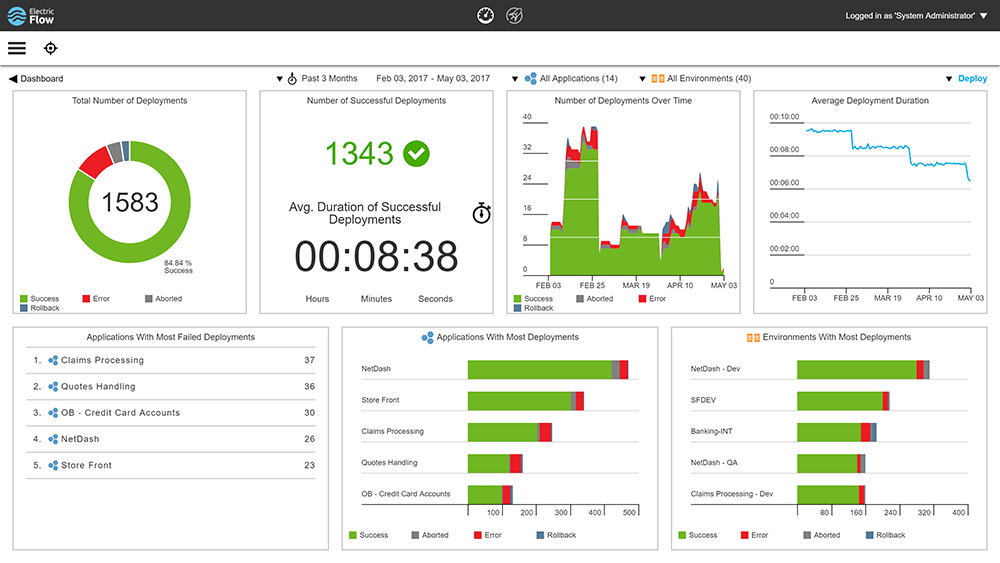Electric Cloud Delivers Rich Analytics for DevOps; Correlates Data and Views from Multiple Tools
Electric Cloud’s latest application releases automation tool Electric Flow 8.0 brings a new dimension of insight to DevOps. The updated release can capture metrics from dozens, if not hundreds of tools across the software delivery pipeline. Further, it can correlate that data into centralized, custom dashboards.
by Vance McCarthy
Tags: analytics, CI/CD, DevOps, Jenkins, JIRA, pipeline, software delivery,

vp marketing
"The key to success with DevOps is fast feedback with meaningful metrics. Teams need a simpler and repeatable way to collect and view information from any DevOps tool along the pipeline."
Integration & APIs
 Enterprise-Grade Integration Across Cloud and On-Premise
Enterprise-Grade Integration Across Cloud and On-PremiseAs companies mature in their adoption of DevOps, many are discovering a critical key to on-going improvements: Metrics -- deep, varied, correlated and quickly discernable.
Electric Cloud’s latest upgrade tackles this need for more and faster metrics head on. The company’s Electric Flow 8.0 adds DevOps Insights Analytics, which sports foundation technologies to capture and correlate meaningful data from dozens, if not hundreds, of tools across company’s toolchain and software delivery pipeline, according to Sam Fell, Electric Cloud’s vice president of marketing.
“The most valuable information is buried in thousands of data points from dozens of tools. Electric flow 8.0 connects the dots for performance indicators -- what are my success rates, where did I have the most failures, how long are my deployments taking and more,” Fell told IDN.
“We talked with a lot of customers who asked us for a simple, repeatable way to collect and view information from any DevOps tool along the pipeline – and put that data in context of a single release,” he said.
“The key to success with DevOps is fast feedback with meaningful metrics,” Fell said. But this is difficult to achieve, especially as many organizations now report using software delivery pipelines made up of 50 tools – or more. “To get fast feedback and move more quickly, teams really need a simpler and repeatable way to collect and view information from any DevOps tool along the pipeline,” he told IDN.
“We hear from customers all the time, ‘Can you help us better understand how we’re doing with releases and deployments, from an efficiency perspective,’” Fell added.
Forrester Research issued a report this summer on issues impacting software delivery explained the problem this way:
“Many vendors are focused on the ‘workflow’ problem, but few are focused on being able to link the status of a build in the pipeline back to the status of a user story, an epic, a business capability, or a customer outcome. . . .As pipelines multiply and products are composed out of many different services, rolling this data up will become even more important. Right now, business leaders lack an easy way to understand whether a particular release will actually deliver the business value they were hoping for.” [Forrester August, 2017 TechRadar on Continuous Software Delivery.]
To respond to this growing need, Electric Flow 8.0 provides teams with automated data collection and reporting “to connect DevOps toolchain metrics and performance back to the milestones and business value - and present it on an easy-to-consume dashboard in real-time,” he said.
With DevOps Insights, Electric Flow 8.0 “can gather all the data they need for that deep understand of how they’re doing,” Fell said. “Once data is captured and correlated, insights (in aggregate or on an individual release) are presented in an easy-to-consume dashboard to better highlight valuable information about features, user stories and more,” he added.
Under the covers, Electric Flow 8.0 sports a number of technologies that work together to deliver these deeper, penetrating, and real-time insights, including:
Data-savvy plug-in connectors – Electric Flow 8.0 adds DevOps Insight Data Collection (Plugins, SDK) to collect data from multiple tools across the toolchain. By extending ElectricFlow’s existing catalog of off-the-shelf plug-ins, DevOps Insights can pull key metrics from any tools being orchestrated as part of the end-to-end delivery process—from user story tracking and build automation to test automation and operations, Fell said.
The data collectors are designed with intelligence and thus more than simply providing raw data dumps from logs, he added. “We have specially designed these interfaces so we can query valuable data from outside tools and pull that data into our object model” which speeds correlation and even supports presentation of release-specific information, Fell said.
This data, in turn, is combined with Electric Flow’s own data to create DevOps insights, he added. “Updated plug-ins in Electric Flow 8.0 are available for Jenkins, JIRA, HPQC and ServiceNow – with more coming,” Fell said. Electric Cloud is taking an open approach to these connectors, as it is also shipping an SDK that lets users build their own data collection extensions.
Correlation engine – Electric Flow 8.0’s DevOps Insight Server provides a powerful analytics layer to unlock DevOps insights (and historical trends and hindsight). Based on ElasticSearch and LogStash, this technology now sports an improved reporting object model (based on ARA primitives). Further, an extensible reporting object model allows teams to collect, analyze and report on metrics that matter to them.

“The upgrade brings a ton of automation to assimilating data from various tools,” Fell said, “eliminating many manual steps (scraping data from multiple tools, cut-and-pasting into spreadsheets, etc.) often needed to understand the status of individual features or stories in a release to accelerate build automation test automation and operations.”
Intelligent, customizable dashboard – Electric Flow 8.0’s dashboard, known as the Release Command Center, provides a single, centralized view to connect the dots between correlated data from multiple underlying tools and meaningful KPIs. Dashboards can be customized (via a drag-and-drop GUI or Domain Specific Language (DSL), based on Apache Groovy language.
It let users drill down on time windows, filter on deployments and releases, measure and track status of those releases and even help determine areas for increased efficiency (and risk) for pipelines and releases.
Reporting object model – To speed and simplify correlation of data for insights on releases, pipelines, applications and environments in a structured way.
Electric Flow DevOps Insight is delivered as a tightly integrated stand-alone Business Intelligence (BI) server, which isolates reporting requests from pipeline orchestration to eliminate the threat of performance impact, Fell added.
Other Notable Upgrades in Electric Flow 8.0
Beyond DevOps Insights, Electric Flow 8.0 also delivers some other often-requested features to promote flexibility and speed – without sacrificing control and auditability, Fell said.
Chief among them is the ability to re-start failed pipelines, right from the place where they stopped / failed. “Often, most solutions require users to restart from the beginning if they want to audit their results. This wastes valuable time and creates a lot of re-work that may not be necessary to get to the root of the problem,” Fell said.
Electric Flow 8.0 lets users “easily restart their pipelines from any failure point,” he said. “This lets teams more quickly focus on locating and fixing the fault, and cutting hours off of the need to do costly re-runs on work they already know is OK,” Fell added.
Other features in Electric Flow 8.0 include:
Customizable Self Service Catalog to empower users. This exposes DevOps automation to users with just a few clicks. A set of new UI menus for creating and modifying catalogs and items in the self-service catalog simplify the ability to bring custom automation into the catalog.
New Pipeline and Release Options to improve authoring and flexibility.
- Pipeline tasks can now directly call a command block, making it easy to incorporate custom scripts and actions right into your pipeline.
- The new ‘Always Run’ option indicates that a pipeline task will be invoked even if there is a failure earlier in the pipeline, guaranteeing that cleanup or other tasks will always be run.
- Rolling deployment options are now available in the release definition on the deployer tasks, so different phases of the rolling deployment can be run separately with checks in between, ensuring successful and safe deployment.
Early response for Electric Flow customers is optimistic.
“Our releases have many moving parts, and touch many teams,” John Esser, senior director of data center operations and SaaS at AdvancedMD said in a statement. “Manual data collection, the lack of consistent metric reporting and other ad-hoc analysis techniques and tools made it difficult for us to report on release payload and status quickly, accurately, and consistently. With the new ElectricFlow release, we look forward to simplifying data collection to make it easier to slice and dice the data to optimize our delivery pipelines and gain up-to-the-minute insights about individual application releases,” he added.
Electric Cloud 8.0 with DevOps Insight is available now. DevOps Insight will be available for free for new ElectricFlow subscriptions during 2017. ElectricFlow Community Edition, including DevOps Insight, can be downloaded and used at no charge http://electric-cloud.com/products/electricflow/.
Related:
- Salesforce Partner Conga Turns to AI/ ML For Smart End-to-End Documents & Contract Management
- With Expanded Machine Learning Capabilities Across Portfolio, Splunk Unveils New Use Cases
- Can AI Transform Application Testing?
- Riverbed Improves ‘Digital Experience Management’ with Latest SteelCentral Update
- DataDog Monitoring Integrates with AWS CodeDeploy To Help Developers More Easily Locate, Resolve Faulty Deployments
All rights reserved © 2025 Enterprise Integration News, Inc.


